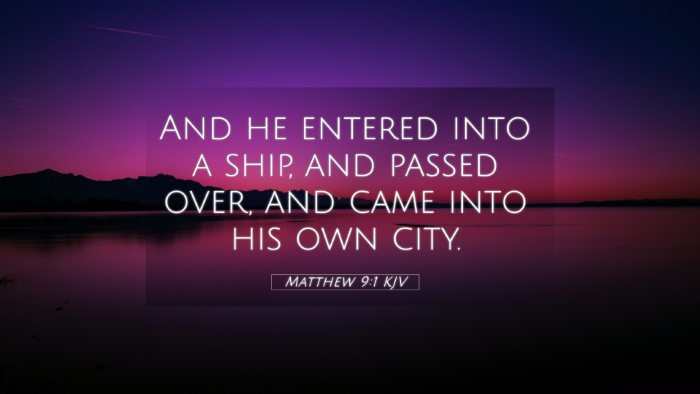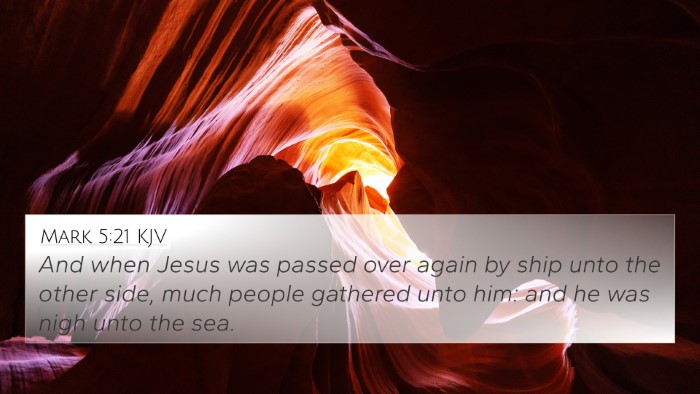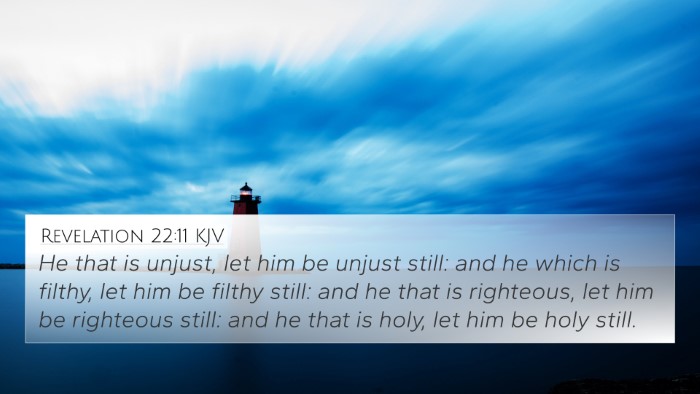Matthew 9:1 - Understanding the Verse
Verse Reference: Matthew 9:1
In this verse, we witness Jesus returning to His own city after an important ministry event. This return signifies both a physical location and a deeper spiritual journey. As per the insights of Matthew Henry, this moment emphasizes the importance of Jesus’ ministry in Capernaum, showcasing His authority and miraculous power. Albert Barnes adds that this act of returning underlines His compassion for the people who had witnessed His miracles and teachings.
Context and Setting
Matthew 9:1 begins a new section in Matthew's gospel, marking a pivotal point. Adam Clarke reflects on how this transition sets the stage for further miraculous acts and teachings, establishing Jesus as not just a teacher, but a healer and savior. It indicates that His ministry is multi-faceted, addressing both physical needs and spiritual truths.
Cross-References Related to Matthew 9:1
- Mark 2:1-12: The healing of the paralytic illustrates Jesus’ authority to forgive sins, a theme echoed in Matthew 9:1.
- Luke 5:17-26: This passage parallels the miraculous healing of the paralytic, emphasizing faith and forgiveness.
- Isaiah 53:5: This prophecy highlights the healing power of the Messiah, affirming Jesus’ role in our healing.
- Matthew 4:13: Jesus’ establishment in Capernaum connects to His ministry, confirming the significance of this region.
- John 5:8-9: This account of another healing echoes the theme of Jesus’ miraculous works and authority over sickness.
- Matthew 8:14-15: The healing of Peter’s mother-in-law showcases the immediate power of Jesus’ touch, setting the stage for further healing in Matthew 9.
- Matthew 9:35: This verse summarizes Jesus’ comprehensive ministry among the people, related to the context of Matthew 9:1.
- Luke 7:22: Jesus emphasizes His works—including healing—as proof of His messianic identity.
- Acts 10:38: This reference to Jesus’ ministry encapsulates the healing and deliverance that characterized His life.
- Jeremiah 30:17: This prophecy speaks to God’s promise of restoration and healing, applying directly to the works of Jesus.
Thematic Connections
This verse draws on various themes prevalent throughout Scripture. According to commentary from Henry, the theme of healing and forgiveness forms a critical link between this and multiple other biblical passages. By examining the inter-Biblical dialogue between these references, we see a consistent message: Jesus is both the deliverer from physical maladies and the forgiver of sins.
Insights from Public Domain Commentaries
Commentators like Albert Barnes emphasize the notion that Jesus’ actions are filled with purpose; His return to Capernaum is not merely geographical but a function of His mission. Adam Clarke elaborates on the aspect of faith, highlighting how these narratives invite believers to trust in Christ's power and compassion. Moreover, Henry notes the continual need for Christ’s healing touch in both a physical and spiritual sense.
Application of Matthew 9:1
This verse encourages believers to recognize the ongoing work of Christ in their lives. The return signifies hope and restoration, reminding us that Christ is ever-present in our circumstances. Through the process of cross-referencing, readers can identify and understand the broader narrative of healing and redemption found throughout the scriptures.
Tools for Further Study
To delve deeper into the connections between Bible verses, consider utilizing:
- Bible Concordance: A useful tool for finding related verses based on keywords.
- Bible Cross-Reference Guide: These guides help to illuminate connections between various scriptures.
- Bible Chain References: This method visually tracks themes across the Bible.
- Cross-Referencing Bible Study Methods: Techniques to enhance understanding of scripture's interconnectedness.
Conclusion
Matthew 9:1 is not only a moment in the life of Christ but a profound invitation for believers to explore the depths of Scripture. It invites readers to engage in comparative Bible verse analysis and thematic connections that deepen their faith journey. Through thoughtful study of cross-references, believers can uncover the rich tapestry of God’s word and the message of redemption and healing that resonates throughout the Bible.









